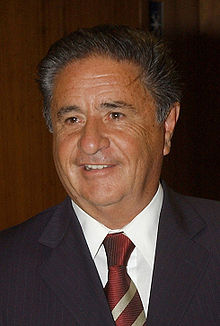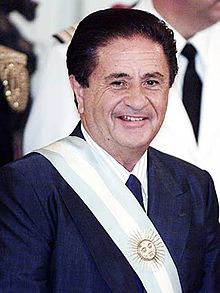Eduardo Duhalde
Eduardo Alberto Duhalde Maldonado (born October 5, 1941 in Lomas de Zamora , Buenos Aires Province ) is an Argentine politician who was President of Argentina between January 2, 2002 and May 25, 2003 . Before that, he was governor of the province of Buenos Aires from 1991 to 1999 .
Life

Eduardo Duhalde, son of a bank clerk and a housewife, graduated from the Universidad de Buenos Aires with a degree in law in 1970 . In 1971 he married Hilda Beatriz González , also known as Chiche Duhalde.
In 1987 he moved to the Chamber of Deputies of Congress and in the same year he was appointed Vice-President of that Chamber. From about this time onwards, his political career was increasingly linked to that of Carlos Menem . Menem finally called on Duhalde to join him in the internal party primaries for the 1989 presidential election. In the primaries on July 9, 1988, the Formula Menem-Duhalde prevailed against Cafiero-De la Sota. When Menem prevailed in the presidential elections on May 14, 1989 against the ruling Unión Cívica Radical under the outgoing President Raúl Alfonsín , Eduardo Duhalde became Vice President of Argentina. An office that is of relatively little importance in Argentina.
Duhalde, who was striving for higher things, therefore applied for the post of governor of the province of Buenos Aires. This office is seen as the second most important office after the president, since 38% of the population live in the province of Buenos Aires and 32% of the gross domestic product is generated.
In August 1991 Eduardo Duhalde won the internal party primaries for the gubernatorial elections. On December 10th he became governor of the province of Buenos Aires. Its provincial social policy led to excessive government spending. The corruption allegations also increased.
His wife set up a social program with the help of housewives - the so-called Manzaneras - which reminded of the social commitment and social programs of Eva Perón ( Evita ).
On October 2, 1994 Duhalde won a referendum with 61.5%, which should allow him a second term. He followed the example of Menem, who was able to run for a second term through a constitutional amendment. On May 14, 1995, he was re-elected governor with 56.7% of the vote.
Duhalde slowly moved away from Menem again, as he harbored the desire to become president himself. He therefore called for internal party primaries for the presidential elections of 1999, for which Menem naturally wanted to run without primaries. Menem assumed that he could run again in the presidential election, since he was elected for the first time after the constitutional amendment in 1995. His third candidacy is actually only the second under the new constitution. It was then determined by the Chamber of Deputies that Menem could not run again and so on June 16, 1999, the Formula Eduard Duhalde-Ramón Palito Ortega, a former singer and governor of Tucumán , was entered into the running for the presidential elections without internal party candidates. In the elections on October 24, 1999, however, they lost to the alliance of UCR and Fepaso with their candidate Fernando de la Rúa .
Thereupon Eduardo Duhalde moved into the state chamber of the Argentine Congress as senator and thus remained on the political stage.
When Fernando de la Rúa resigned from the office of president on December 21, 2001 after economic and political unrest, the Argentine constitution meant that the vice-president should have assumed the office of president. Vice-President Carlos Álvarez had already resigned his office in October 2000 and this post has been vacant since then. Next in line was, according to the constitution, Ramón Puerta , Chairman of the Senate. However, he was overwhelmed with this task from the start and was happy when he was able to hand over the presidential sash to Adolfo Rodríguez Saá on December 23rd .
After just under a week, he could no longer hope for the support of the population and his own party. At a meeting of all Peronist provincial governors he called on December 30, 2001, only six out of fourteen governors attended. Disappointed, Rodriguez Saá traveled to San Luis and announced his resignation from there.
Since Ramón Puerta, Chairman of the Chamber of Senators, had no interest in becoming interim president again, Eduardo Camaño became President of Argentina as President of the Chamber of Deputies on December 31st. On the first day of the new year, Eduardo Duhalde was elected as the new president. He became the fifth president of Argentina in just 13 days.
As President of Argentina, he tried to escape the economic crisis by ordering the devaluation of the Argentine peso from 1 peso per US dollar to an initial 1.40 peso per US dollar. The 1: 1 parity of the peso with the US dollar, which had lasted for over ten years and which many experts see in retrospect as the source of the Argentine economic crisis, was over. Since then, the value of the Argentine peso has temporarily dropped to just 25% of its original value.
Eduardo Duhalde was replaced as President on May 25, 2003 by Néstor Kirchner, who was directly elected by the people .
In October 2003 Duhalde was elected the first President of the newly created Commission of Permanent Representatives of Mercosur , he took office on December 16 of the same year.
Duhalde entered the 2011 presidential election for the Unión Popular party and won around 5.9 percent of the votes cast.
Web links
- Detailed biography (Spanish)
- Website developed by Grupo de Apoyo Comunicacional Eduardo Duhalde (Spanish)
- Biography in the Munzinger archive (beginning of article freely available)
Individual evidence
- ↑ Eduardo "the Fifth" Duhalde - El Cabezon , lateinamerika-nachrichten.de , accessed on 16 February 2021 (incorrectly Duhalde is named as the fifth president in two weeks)
- ↑ Foreign debt: Argentina defaults on payments. handelsblatt.com, January 4, 2002, accessed February 16, 2021 .
- ^ Argentina: runoff between Menem and Kirchner. Der Spiegel , April 28, 2003, accessed February 16, 2021 .
- ↑ Institutional consolidation in MERCOSUR: new president, new face , announcement from the Konrad-Adenauer-Stiftung
| predecessor | government office | successor |
|---|---|---|
| Eduardo Camaño |
President of Argentina 2002–2003 |
Néstor Kirchner |
| personal data | |
|---|---|
| SURNAME | Duhalde, Eduardo |
| ALTERNATIVE NAMES | Duhalde Maldonado, Eduardo Alberto (full name) |
| BRIEF DESCRIPTION | Argentine politician |
| BIRTH DATE | October 5, 1941 |
| PLACE OF BIRTH | Lomas de Zamora , Buenos Aires Province |

